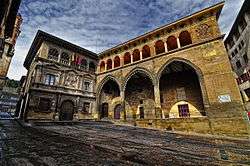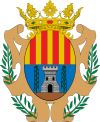Alcañiz
| Alcañiz | |||
|---|---|---|---|
|
| |||
| |||
 Location in Spain | |||
| Coordinates: 41°2′5″N 0°7′50″W / 41.03472°N 0.13056°WCoordinates: 41°2′5″N 0°7′50″W / 41.03472°N 0.13056°W | |||
| Country | Spain | ||
| Autonomous community | Aragon | ||
| Province | Teruel | ||
| Comarca | Bajo Aragón | ||
| Government | |||
| • Mayor | Juan Carlos Gracia Suso | ||
| Area | |||
| • Total | 472.12 km2 (182.29 sq mi) | ||
| Elevation | 340 m (1,120 ft) | ||
| Population (2009) | |||
| • Total | 16,392 | ||
| • Density | 35/km2 (90/sq mi) | ||
| Demonym(s) | Alcañizanos | ||
| Time zone | CET (UTC+1) | ||
| • Summer (DST) | CEST (UTC+2) | ||
| Postal code | 44600 | ||
| Website | Official website | ||

Alcañiz (Spanish pronunciation: [alkaˈɲiθ]) is a town and municipality in the province of Teruel, in the autonomous community of Aragon, Spain. The town is located on the banks of the river Guadalope. Alcañiz is the unofficial capital of the Lower Aragon historical region. Its distance from Teruel, the provincial capital, is 149 kilometres and from Zaragoza, the capital of Aragon, 105 kilometres.
Alcañiz is the capital of the Bajo Aragón comarca and the second city in the province after Teruel.
History
The current settlement of Alcañiz dates to the Islamic era in Spain. It was captured by the Christian troops of Alfonso I of Aragon in 1119, but was later taken back by the Moors. It was conquered again by count Ramon Berenguer IV of Barcelona in 1157, and again lost, until it was finally recaptured by his son Alfonso II of Aragon. In 1179 the latter gave the town the military Order of Calatrava
On 23 May 1809 during the Peninsular War, the Battle of Alcañiz was fought between a Spanish force led by General Blake and French troops commanded by General Suchet. During French occupation Suchet made an administrative territorial division of Aragon by which Alcañiz became the capital of the province of Alcañiz. This short-lived province briefly unified the Lower Aragon historical region.[1] Alcañiz, however was bypassed in the 1833 territorial division of Spain and later attempts to create an Alcañiz Province were not successful.
Formerly there was a railway line between Alcañiz and Tortosa, offering a new gateway to the sea for Aragon through this town. Construction work began in 1891, but it was haphazard and the first trains between Alcañiz and Tortosa began only in 1942. The last stretch between Tortosa and Sant Carles de la Ràpita was never completed before the line was terminated by RENFE in 1973.[2]
Jewish history
in 1380, a few Jewish families, scattered in the surroundings of the town, joined to community, which was under the jurisdiction of the Order of Calatrava. During the massacres of 1391, the Jewish community in town was protected. Alcañiz was the hometown of Joshua Lorki, a converted Jew who initiated the religious Disputation of Tortosa between Christian and Jewish scholars.[3] A law was forced on the town Jewish community, imposing a fine on any Jew who wished to move out of the city. Most of the town Jews eventually converted to Christianity, before or during the Spanish Inquisition in 1492.[4]
Main sights
Sights in Alcañiz include:
- Church of Santa María la Mayor, including a medieval Gothic tower.
- Lonja de Alcañiz
- Casa Consistorial (Town Hall; 1565-1570)
A few kilometers from the city are the rock paintings of the Val del Charco del Agua Amarga, included in the UNESCO Heritage Site Rock Art of the Mediterranean Basin on the Iberian Peninsula .
See also
References
- ↑ Eliseo Serrano Martín, El Matarraña y la Historia Moderna. Portal Aragon.
- ↑ Historia de la línea de La Puebla de Híjar-Alcañiz-Tortosa-Sant Carles de la Ràpita
- ↑ https://www.jewishvirtuallibrary.org/jsource/judaica/ejud_0002_0001_0_00701.html
- ↑ http://jewishencyclopedia.com/articles/1093-alcaniz
External links
| Wikimedia Commons has media related to Alcañiz. |
- Official website (Spanish)
- The battle of Alcañiz — De Re Militari (Spanish)
- Alcañiz.tk (English)

